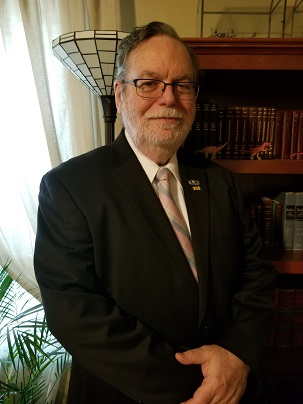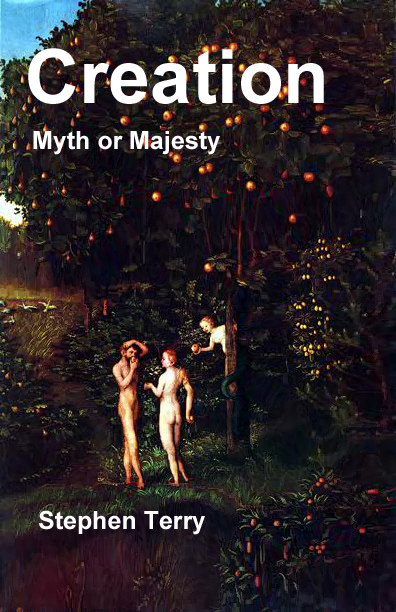
Stephen
Terry, Director

From Confession to Consolation
Commentary
for the March 7, 2020 Sabbath School Lesson
 "Seventy
'sevens' are decreed for your people and your holy city to finish transgression,
to put an end to sin, to atone for wickedness, to bring in everlasting
righteousness, to seal up vision and prophecy and to anoint the Most Holy
Place." Daniel 9:24, NIV
"Seventy
'sevens' are decreed for your people and your holy city to finish transgression,
to put an end to sin, to atone for wickedness, to bring in everlasting
righteousness, to seal up vision and prophecy and to anoint the Most Holy
Place." Daniel 9:24, NIV
When
examining the prophetic timelines of the book of Daniel in the Old Testament, there
may be a questionable basis for the time prophecies of Daniel 8:14 and Daniel
9:24 having the same starting point. Daniel 9:24's seventy weeks are well
identified as to its beginning and using the year for a day principle used when
God appointed a year for each day the spies had traveled in Canaan for the
wandering of the Israelites in the wilderness, it appears to work historically
for the events regarding the Advent and crucifixion of Christ.
But
in order to harmonize with the commencement of the Investigative Judgment in
1844, some have insisted that the Hebrew verb in 9:24, נֶחְתַּ֥ךְ
means "cut off" and therefore must be referring to being severed from
a larger time line, the closest physically within the text of Daniel being the
2300 days of Daniel 8:14. However the word more correctly means
"decreed" or "determined" as is correctly rendered in
practically all translations, including the King James Version. This is also
the translation given in William Holladay's authoritative work, "A Concise
Hebrew and Aramaic Lexicon of the Old Testament."
The
"cut off" interpretation may have found its way into Adventism from
John Gill's "Exposition of the Bible" commentary where such an
interpretation is given. He does not say where he obtained the idea. John Gill
was an English Baptist theologian who wrote in the mid-eighteenth century and
his commentary was commonly used for reference during the Millerite era and the
formative years of Seventh-day Adventism. They did not have the plethora of
sources we now have for biblical study, and this meant that a single author,
once published, could have a far greater influence over popular understanding
than we might expect today. This means an error, even an unintentional one,
could persist. We see an example of this influence in the commentary
accompanying the Scofield Reference Bible of 1909, where the Secret Rapture
doctrine was promoted and persists to the present, influencing later works by
Hal Lindsey and others. Even though that doctrine is based on an
interpretation, those who believe in the Secret Rapture are just as convinced
in their belief as are many Seventh-day Adventists regarding the inerrancy of John
Gill's interpretation of Daniel 9:24.
Not
surprisingly, Ellen White echoes John Gill's statement about the "cut
off" interpretation verbatim with her statement regarding Daniel 9:24 in
"The Great Controversy," page 326. Other scholars have pointed out
repeatedly that she drew on secular historical sources for some portions of
"The Great Controversy," such as d'Aubign?''s "History of the
Reformation of the Sixteenth Century" published in 1800. While popular and
important works in their time, some of the information from those sources has
later been challenged. Should it be unusual then that she should also draw on a
popular non-Adventist theologian's commentary? However, it does bring into
question our understanding of inspiration regarding the vision later claimed by
Hiram Edson, which may have been influenced by William Miller, who himself may
have based his understanding on Gill's statement concerning Daniel 9:24 made
perhaps a century earlier. Ellen White's inspiration regarding the text may be
a fruit of the same tree. It is possible that neither party knew directly of
John Gill's statement and only received it via William Miller's exposure to it.
We don't know, since sources were not cited then as they are now. But even
still, it challenges our concept of inspiration. While it is impossible to say
exactly what Ellen White read or didn't read without an index to her personal
library, the language used and the coincidence bring up the question especially
in view of the popularity of Gill's "Exposition on the Bible."
The
"Seventh-day Adventist Bible Commentary" on Daniel 9:24 also states
that they are going with the interpretation of "cut off" as opposed
to "determined." without citing the exact source of such an
interpretation except to say that it appears "in post-biblical
Hebrew." Sometimes what passes for scholarship in Adventist circles
surprises me because the author does not give a single example of such a
reading. He does cite sources where the translation differs slightly but not
one that actually corroborates the translation "cut off." Then as if
frustrated at his lack of a concrete reference example, he states that the
meaning must instead "be derived from context" and then begins a
short diatribe of circular reasoning to arrive at his predetermined conclusion
that it does indeed mean "cut off." However, if as a denomination,
Adventists believe in any degree in inspirational infallibility it could be
expected that the denomination's official commentary would necessarily be in
harmony with the prophetess's statement, even if she was only quoting John
Gill.
The
untoward influence of this interpretation of Daniel 9:24 became a focal point
for a disappointed group of Millerites. William Miller had predicted the
Parousia would take place first in 1843 and then when that did not happen, in
1844 based apparently on the Gill influenced assumption that the time period of
Daniel 9:24 and Daniel 8:14 began running on the same date. When the Parousia
did not take place, rather than call into question this assumption or even the
idea of what the "re-consecration (or cleansing) of the sanctuary"
might be referring to, this 19th century band of believers refused to admit
that the calculation or the interpretation could be off. Into this stew pot
came farmer and lay faith-healer, Hiram Edson, with his own contribution. He
proclaimed to the band of believers that were to become the nascent Seventh-day
Adventist Church a couple of decades later that the reason nothing happened in
1844 was that it was all invisible due to taking place in heaven instead of on
Earth. This idea came to be known as the "Investigative Judgment."
Eventually it was determined that this judgment had a process whereby it began
with God's judgment of those who had died and would end with the living, and it
begins with Christ entering the presence of God in the Most Holy Place in the
heavenly temple in 1844. Consequently there has developed a heavy reliance on
the priestly ministry of Christ described in Hebrews. There is some controversy
regarding this interpretation, though, as Stephen, the deacon, when stoned by
his persecutors, stated he could see Jesus standing "at the right hand of
God." (Acts 7:56) If this is correct, then Jesus would have to leave the
presence of God in order to re-enter his presence. While possible, there is no
biblical account of such a separation taking place after the Ascension.
Admittedly, it is difficult to envision what takes place on a corporeal level
with an ineffable God who is Spirit and capable of omnipresence.
This
ready acceptance of Edson's vision may seem to some like a facile attempt to
rationalize what had happened without abandoning the interpretation that
apparently originated with Reverend Gill. However, to those believers, it
provided an explanation they could run with and a defense against those who
were accusing them of folly in setting a date for the Second Coming, a practice
which the Bible says is futile. (Matthew 24:36) Such an interpretation allowed
them to deny they were in error and to escape the charge of date setting for
the Parousia. After all, it turned out it wasn't really the Second Coming they
were predicting, it was the start of the judgment.
One
would think upon examining the "Fundamental Statement of Beliefs"
voted in Dallas in 1980 that very little of our theology depends on this
Doctrine of the Investigative Judgment. Without it, the denominational name
remains intact, for the fact of the Parousia is well established Christian
doctrine, and the Seventh-day Sabbath is also well founded both biblically and
in Ante-Nicene Christianity. However, some have viewed the Investigative Judgment
as a cross to die upon, even going so far as to defrock ministers who dared to
question it. Yet, this is the same church that several decades ago would also
fire pastors who baptized individuals who chose to wear wedding rings, a
practice that today is rarely if ever questioned, many ministers as well as lay
members having taken up wearing them. If this doctrine on wedding rings, which
was considered so vital only a short time ago, could be revisited, why not the
idea of an Investigative Judgment that began in 1844, a year that by any other
account was unremarkable save for the failure of Jesus to appear.
Of
course this begs the question of just what Daniel 8:14 is referring to. We feel
we must have that answer because 1) we believe that this is the Time of the
End, and 2) The final chapter of Daniel says that the book will be unsealed at
the "Time of the End." (Daniel 12:9) Because Adventism claims to be
the End Time remnant of Revelation 12:17, that implies that we must therefore
have the correct understanding of the unsealed book of Daniel. We cannot then
abide any ambiguity regarding Daniel 8:14. But reality challenges us even there
for there is plenty of ambiguity regarding our understanding of Daniel, chapter
11. It may be presumption then to assert that we are the people who have been
specially chosen to open Daniel to the world. We may be just as wrong about the
imminence of the Parousia as were the first century believers. But while an
individual may come to admit they were wrong and take a more enlightened path
as a natural part of spiritual growth, it is much more difficult, if not
impossible for a corporation supported by millions of members to do so,
especially if that corporation is dependent upon the continued financial
support of those members for its existence. Perhaps this is why Christianity
tends to progress by the establishment of new denominations instead of through
reformation of the existing ones. Even the great Reformation of the sixteenth
century was more an exodus from the Roman Church rather than a welcome
invitation to actual reformation from within. It begs the question whether each
denomination in turn must pass through that gate to progress.
In
any event, in the previous chapter, I have offered a meaning for Daniel 8:14
contemporary to the events transpiring when the book was likely written.
Daniel, as we have it today, was very much a product of the Maccabean Revolt
and that context provides us with keys to understanding the meaning and purpose
of the text, again, as addressed in the last chapter of our commentary. While
there is little doubt that a judgment precedes Christ's return in order to
enable Revelation 22:12, there is no indication that setting a date for a
beginning for such judgment has any relevance at all to salvation or the Second
Advent. What possible difference could it make if such judgment began in 1844
or 1910, or any other subsequent date? Perhaps it is time to toss such
theological date setting into the rubbish bin of history. The imminence of the
Second Coming does not need that to be apparent for the signs repeatedly
mentioned in the Bible abound around us. Let's stop the date setting and
prepare. It may be sooner than we think.
